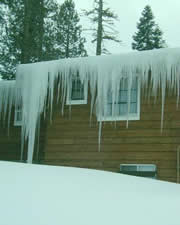
Dimdima
Online Children's Magazine from India

Dimdima
Online Children's Magazine from India

Próspero Año Nuevo to all my little friends! I’m spending New Year’s Eve with my friends in New York, and this morning, I woke up to a wonderful sight. Upon looking out the window, I saw that the whole neighborhood was covered in a white blanket of snow. In fact, soft snowflakes are still drifting down lazily from the sky. Since my mind is consumed with the picture outside my window, my letter to you today will delve deeper into the mysterious conditions that cause snowstorms.
Simply put, snow is nothing but frozen rain. When cold air masses from the polar-regions move to warmer parts of the globe, they collide with the warm air masses of those regions. The warm air rises, and the cold air forms huge clouds. Because the temperature inside these cloud masses is below freezing, water vapor trapped inside the cloud turns into ice. Snowflakes are formed when tiny ice crystals stick together. When the clouds get really heavy, precipitation occurs. Depending on the temperature of the air between the bottom of the cloud, and the top of the ground, precipitation can take the form of rain, sleet, or snow. In warm places, precipitation occurs in the form of rain. In colder places, it can take the form of sleet, and in really cold temperatures, sleet turns into snow.
Individual snowflakes are like our fingerprints. No two flakes are identical. In fact, the only common thing about snowflakes is that they are all hexagonal in shape. If you observe a snowflake under a microscope, you will be amazed at the beautiful lace-like patterns they resemble.
Although snow is a beautiful thing, it  can prove to be very harmful to humans. The worst snowstorms are known as blizzards. Under these conditions, the wind blows huge piles of snow, known as snowdrifts. People, houses, trees, animals, and vehicles can get buried under these drifts. Because snow is white in color, it reflects the sun’s rays with great intensity. Sometimes, after a severe blizzard, there is so much snow on the ground that it becomes extremely bright, and we cannot tell where the earth ends and where the sky begins. This is known as a “whiteout.” Whiteout conditions are like mirages in a desert. They disorient animals and confuse or hypnotize drivers, causing accidents to occur.
can prove to be very harmful to humans. The worst snowstorms are known as blizzards. Under these conditions, the wind blows huge piles of snow, known as snowdrifts. People, houses, trees, animals, and vehicles can get buried under these drifts. Because snow is white in color, it reflects the sun’s rays with great intensity. Sometimes, after a severe blizzard, there is so much snow on the ground that it becomes extremely bright, and we cannot tell where the earth ends and where the sky begins. This is known as a “whiteout.” Whiteout conditions are like mirages in a desert. They disorient animals and confuse or hypnotize drivers, causing accidents to occur.
In the United States, snowstorms disrupt normal everyday life every winter. Blocked roads, fallen telephone and electric lines, vehicular accidents, and frostbite are only a few of the challenges we face. American citizens, therefore, always pay heed to warnings issued by local weather bureaus during the winter months. Most Americans keep a few days’ worth of food supplies in their pantries at home, to ensure survival in case they are stranded in their homes during a blizzard. Most of the stored food are canned or packaged and do not need heating or cooking. This ensures food supply if the gas and electric lines are down. We always dress warm, and try to stay indoors as much as possible.
Despite the bleak outlook, the winter months can still prove to be a lot of fun. Children love to play outside after a fresh snowfall. They make snow angels, build snowmen, and have snowball fights amongst themselves. Skiing and ice- skating are other activities that children and adults enjoy during the winter months. Common sense and co-operation with the authorities is all it takes to divert disaster. While accidents cannot always be ruled out, winter is still an enjoyable time for most Americans.
That’s it for this time, amigos. Don’t forget to join me for another journey next fortnight!
Notes:
Próspero Año Nuevo = Spanish for “Happy New Year”
Sleet = slushy, cold rain
Amigos = Spanish for “friends”
Dimdima is the Sanskrit word for ‘drumbeat’. In olden days, victory in battle was heralded by the beat of drums or any important news to be conveyed to the people used to be accompanied with drumbeats.
Bharatiya Vidya Bhavan
K. M Munshi Marg,
Chowpatty, Mumbai - 400 007
email : editor@dimdima.com
Bharatiya Vidya Bhavan
505, Sane Guruji Marg,
Tardeo, Mumbai - 400 034
email : promo@dimdima.com
Dimdima.com, the Children's Website of Bharatiya Vidya Bhavan launched in 2000 and came out with a Printed version of Dimdima Magazine in 2004. At present the Printed Version have more than 35,000 subscribers from India and Abroad.